
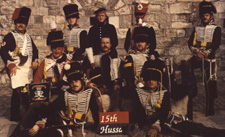 The 15th Hussars mounted reenactment unit
represents 'E' troop of this famous cavalry
regiment as it would have appeared during the era
of the Napoleonic period 1807-15.
The 15th Hussars mounted reenactment unit
represents 'E' troop of this famous cavalry
regiment as it would have appeared during the era
of the Napoleonic period 1807-15.
The origins of the 15th can be traced back to 1759 when the success of light cavalry troops in Europe finally prompted the ever-conservative British War Office at Horse Guards to add a light horse regiment to its army. On 17th March 1759, Major-General George Augustus Elliot raised 'Elliot's Light Dragoons'. The raising coincided with a tailors' strike and many of these men enlisted, thus causing the new unit to be known as 'The Tabs' (from the slang word for tailor). Glory was not kept waiting for long by the new regiment as, the following year, it was sent to Germany as an ally of Frederick the Great of Prussia in the Seven Years War.
The baptism of fire came on 16th July 1760 at the battle of Emsdorf. The Light Dragoons thundered at the charge into the French ranks, capturing 16 stands of colours, six cannon and over 2,600 French! In 1765 King George III inspected the already-famous regiment and bestowed on it the title '15th, the King's Light Dragoons.'
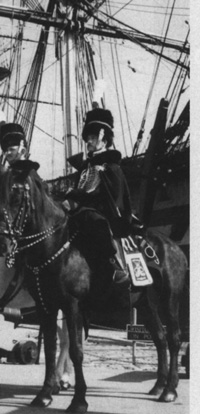 In 1793 Britain was again embroiled in a
conflict with France which was to drag on for
over 20 years - the Napoleonic Wars. In March
1807 the regiment became the '15th (King's)
Light Dragoons (Hussars)' and adopted the then
fashionable Hungarian-style Hussar uniform
worn by the re-enactment unit today.
In 1793 Britain was again embroiled in a
conflict with France which was to drag on for
over 20 years - the Napoleonic Wars. In March
1807 the regiment became the '15th (King's)
Light Dragoons (Hussars)' and adopted the then
fashionable Hungarian-style Hussar uniform
worn by the re-enactment unit today.
During the Napoleonic Wars, the 15th were active on all fronts including The Netherlands, Central Europe, Belgium and, of course, Spain: the 'Spanish Ulcer' and the 'Thorn in Napoleon's Side' . . . both names for the Spanish Peninsular War, 1808 to 1814. The 15th covered themselves in glory during this bitter, hard-fought campaign.
One of their battle honours, and probably their greatest, came at the Spanish town of Sahagun in 1808 where, led by Lord Paget, 300 men of 15th defeated over 600 French Chasseurs Dragoons. In the words of Captain Alexander 'The 15th then halted, wheeled into line, "huzzared" then advanced.' Lord Paget later wrote of the event, 'I have just had an affair with French cavalry and given them a good licking. It was those lucky rogues the 15th, who always happen to be under my hand when there is anything to be done.'
They covered Sir John Moore's retreat during the terrible winter of 1808-9, constantly, turning to hold back the French advance guard and give the weary British a chance to escape. Often holding back many times their own number of enemy cavalry, including (allegedly) a memorable encounter at Morgel de Alaxo with Napoleon's Guard Chasseurs a Cheval, causing many a French infantryman to fear triple-noted charge bugle, followed by shout 'Charge! Charge! Emsdorf and Victory!', accompanied by the thunder of regimented hooves on bloodstained snow.
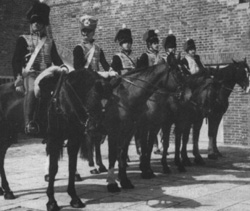 When the Spanish campaign ended in
victory for the British army and its allies in
1814, the 15th retumed home but had little
time for rest as they were soon recalled to the
colours for the Waterloo campaign --
Napoleon's last desperate gamble.
When the Spanish campaign ended in
victory for the British army and its allies in
1814, the 15th retumed home but had little
time for rest as they were soon recalled to the
colours for the Waterloo campaign --
Napoleon's last desperate gamble.
The hussars fought all day on the 18th June 1815 out on the allies' right flank. Under the command of Colonel Grant, and brigaded with the excellent King's German Legion hussars, they faced off the probing attacks of French Lancers, charged the squares of the French Imperial Guard and finally, a glorious charge to silence the roaring 12pdr cannon of Napoleon's Imperial Guard artillery, losing almost half of their already-depleted number in this maelstrom of shot, shell and charging horseflesh. After this came India; 'Assisting the civil power' in Ireland; Afghanistan; and, of course, the horrors of the First World War - but these are (as yet) outside the scope of this re-enactment unit.
UNCLE GEOFF'S FIVE-YEAR PLAN
So, what can you expect and what will be expected of you in the 15th? Well, as any horsed unit in the Association will tell you there is a lot of hard work involved in cavalry re-enactment; the safety and well-being of the horses must take priority at all times. So 'expect to be at home when Captain Muckshovel comes to call!' All cleaning, grooming, feeding and even guarding of the troop horses is carried out by the dragoons of the unit (the horses being the 'troopers', of course!), in an authentic 'living history' bell-tented camp. (Many thanks are due to the ever-helpful Janet Rogers, whose horses E troop use for all UK shows.)
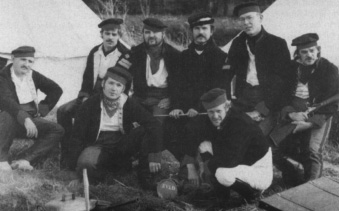 The unit counts
among its number professional regimental
tailors and leatherworkers/saddlers, so those
unfeasible, over-the-top pelisses aren't as
bank-breaking as you might imagine! The
regimental gazette, The Irritant - full of
essential drivel, including the articles that this
upstanding tome could never pnnt - is also
available.
The unit counts
among its number professional regimental
tailors and leatherworkers/saddlers, so those
unfeasible, over-the-top pelisses aren't as
bank-breaking as you might imagine! The
regimental gazette, The Irritant - full of
essential drivel, including the articles that this
upstanding tome could never pnnt - is also
available.
The unit has always been proud of the fact that it shows all aspects of cavalry life in terms of both personnel and itinerary: you will find officers going about their business, both military and, of course (always important), socially . . . something which has even led to period dancing at a large country estate in the care of one of our members! Meanwhile, back in camp, the trumpet calls dragoons to reveille, 'stables' and 'boots and saddles'; there's also the oft-forgotten foot drill and the multitude of dismounted duties the cavalryman has to perform - the 15th are not merely a 'riding club with nicer breeches'!
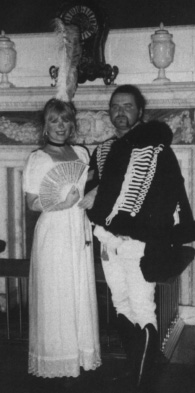 There is another, most important, aspect
of the 15th that demands attention, and that is
the
FUN we have at any given event. Like
any other hobby, enjoyment is one of
the main cntena n so while there is often
hard work to be done and safety
requirements to be observed (especially
where horses are concemed), there are
also, of course, plenty of opportunities
to socialise and sample the native hop
of many countries (and I don't mean the
samba!).
There is another, most important, aspect
of the 15th that demands attention, and that is
the
FUN we have at any given event. Like
any other hobby, enjoyment is one of
the main cntena n so while there is often
hard work to be done and safety
requirements to be observed (especially
where horses are concemed), there are
also, of course, plenty of opportunities
to socialise and sample the native hop
of many countries (and I don't mean the
samba!).
Anyway, on to the aforementioned five-year plan. Our illustrious Captain, (Uncle) Geoff Potts, has a definite plan of campaign for Waterloo 2000, which would see the 15th up to active-service troop strength: two officers, a troop trumpeter, farrier, troop sergeant major, a sergeant, two corporals, a lance-corporal and 24 dragoons, told off as four subdivisions of six, in two ranks. This makes for 33 officers and men. With our establishment currently standing at one officer, a trumpeter, farrier, corporal, lance-corporal, and 12 dragoons - plus of course the Captain's faithful aide, Stiles, and the long-suffering women will combine to enable the 15th to present facets of military equestrian life - Uncle Geoff s plan is already halfway to fruitition.
We have established close ties with today's 15th Hussars, who now, along with the 13th, 18th and 19th Hussars, form the regiment known as The Light Dragoons. We hope to revisit their headquarters in Newcastle this year to maintain these ties; we have, apparently been challenged to a game of polo by the officers of the regiment (Oh blimey! Humiliation beckons).
Contact Information
For further information about t 15th Hussars, please contact: John Lander, 46 Home Close, Histon, Cambridge CB4 4JL
Back to Table of Contents -- First Empire 27
Copyright 1996 by First Empire.